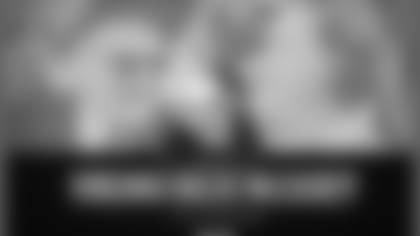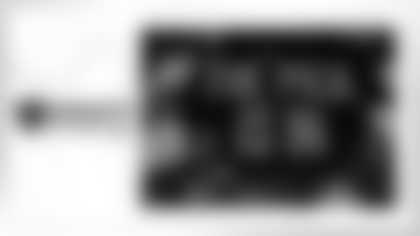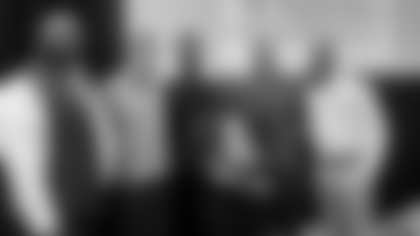The following is the third of four excerpts from theChicago Bears Centennial Scrapbook, which is authored by Hall of Fame writers Dan Pompei and Don Pierson.This passage focuses on the Bears' tradition of legendary middle linebackers.
The history of the middle linebacker began in a defensive huddle during the 1954 season.
That's where nose guard Bill George complained to team captain George Connor that the opponent kept throwing over his head when George stepped forward to engage the center. Connor's advice: back up.
George did, and the middle linebacker was born.
The history of the middle linebacker started in Chicago and includes a chase that ended up over the brick wall, and into the expensive seats at Wrigley Field. That's where Dick Butkus chased Lions running back Altie Taylor, who had angered Butkus by stepping out of bounds before Butkus could get a good hit on him. When Taylor returned to the Detroit huddle, he told teammate Charlie Sanders, "That man's crazy."
The history of the middle linebacker ran through the New Orleans Superdome during the winter of 1986. That's where Mike Singletary was in the middle, literally and figuratively, of arguably the greatest defense anyone has seen, providing direction, calm, precision and ferocity to a group of talented and distinct individuals who might have remained that way without a leader.
The history of the middle linebacker continued in the end zone at Soldier Field in 2007. That's where Brian Urlacher celebrated after he ran 85 yards for a touchdown after intercepting Packers quarterback Brett Favre.
"He had a range in the prime of his career that was as good as any safety, and he was playing middle linebacker," Favre said years later.
Just as Butkus and Singletary did before him, Urlacher redefined the middle linebacker position that George had originally created. And as we head into the second century of Bears football, 2018 first-round draft pick Roquan Smith, making plays all over the field with speed and cunning, seeks to redefine it once more.
Intelligence and toughness connected George, Butkus, Singletary and Urlacher. They understood more than most, because of their instinct and dedication. And they had the fortitude and will to persevere through any challenge, physical or mental.
Many of George's interceptions were the result of his ability to diagnose plays. His defensive coordinator, George Allen, once called George the smartest defensive player he ever coached. In his autobiography, George Halas wrote, "(George) could tell almost instantly where the play was going and put himself into position to stop the run or pass."
Joe Marconi, who played for the Rams and the Bears, said Rams coach Sid Gillman had such respect for George that they named a pass protection after him: "George protection."
In his 14-year run with the Bears, George was revered by his teammates. He was a presence as much as a middle linebacker.
"The man," Ed O'Bradovich called him.
Mike Ditka said that when he came to the Bears, the players did everything together off the field because George mandated it. "Nobody said 'no' to Bill George," Ditka said. "He was a college wrestler. Every so often somebody would want to wrestle him. And they wouldn't do too good."
Carl Brettschneider didn't do too well in
a 1956 brawl between the Cardinals and Bears. According to George Strickler of the Chicago Tribune, George hit the linebacker with "The best punch since Floyd Patterson upset Archie Moore."
George did it all for the Bears—and more. He and his sons even cultivated the backyard garden of Ed and Virginia McCaskey. "Bill George was more than just a player as far as our family was concerned," Virginia McCaskey said. "There were Fourth of July barbeques at his home that were always a big deal to attend. His mother made an afghan for me in Bears colors. It was a very personal and wonderful relationship."
Butkus had a different relationship with management, but as a middle linebacker he was a physical dominator and intimidator in the mold of George. To Butkus, defense wasn't just about tackling. It was about punishing the opposition. He would hit the ballcarrier high and drive him into the ground with ill intent and stunning force. "You mention his name, my body starts aching," said Charlie Sanders, a Hall of Fame tight end.
In one game at Tiger Stadium, the Lions tried playing an I-formation against the Bears. Before the game was over, every member of the Lions' "I"—center, quarterback, fullback and halfback—had been knocked out of the game by Butkus.
Butkus was everything a Bear is supposed to be. He came from a Lithuanian neighborhood on the southeast side of Chicago, attended Chicago Vocational High School and then the University of Illinois.
In October 1971, Playboy Magazine described Butkus: "He's the meanest, angriest, toughest, dirtiest son of a bitch in football. An animal, a savage, subhuman."
Such perceptions never sat well with Butkus. But he didn't do much to change them.
During his playing days, Butkus once told an interviewer, "I sometimes have a dream where I hit a man so hard his head pops off and rolls downfield."
An official in the 1971 Bears-Dolphins game might have thought the same thing. He came out of a pile holding out his finger, which was covered with blood. Butkus allegedly walked away with a sly grin and reddish teeth.
"I used to line up at the outside linebacker position and look inside," Doug Buffone said. "I'd see him hulking over the center. He always had a little blood trickling down his face. I don't know if he would cut himself or what. But I'd always say to myself, 'Thank you, Lord, he's on my side.' "
Hitting came naturally to the great Bears middle linebackers. Former Lions center Kevin Glover once said Singletary was the hardest hitter he ever played against. Legend has it that Singletary broke 16 helmets during his college career at Baylor.
Before he hit his victims, Singletary stared them down. He was as famous for his bulging eyes as he was for his devastating hits.
"Sometimes I'd get up to the line of scrimmage and I'd look at Mike," former Redskins quarterback Joe Theismann said in the NFL Network documentary, 'Mike Singletary: A Football Life'. "You saw the fire in his eyes and the passion in his eyes."
No player was more intense than Singletary. In a 1983 game, the tip of one of his fingers was cut off. Singletary demanded that team doctors stitch it back on. He put a glove over the injured finger and ran back on the field.
At 5-foot-11 and with ordinary speed and athleticism, Singletary wasn't supposed to become one of the greatest linebackers in history. But he refused to be anything less. Singletary played in 10 Pro Bowls but never achieved his primary goal—to play an error-free game.
Singletary, an old soul who was purpose-driven, was the ideal leader for the wild Bears defense of the 1980s.
"He was so different from a lot of the other players," Virginia McCaskey said. "He used to carry his Bible on game trips along with his playbook. He was such a student of the game and also a student of life. Ed came home one day and he said, 'Had a chat with Mike Singletary and he asked me the wrong question. He asked how he could improve as a person. No one had ever asked me that before. It was the darndest thing.' And Mike was serious."
Urlacher may have been the most talented of all the Bears middle linebackers. Former Bears coach Dick Jauron, who was in the league for 36 years as a player and coach, said Urlacher was more gifted than anyone he had seen.
"You can spend all your life coaching certain people, and they still can't make certain plays," Jauron said. "Then a guy like Brian—he may go underneath the block, over the block, through the block. A play that would go for plus eight, or plus 70 against other players, he might run it down for minus four, and he might do it four different ways."
At 6-foot-4, 258 pounds, Urlacher ran a 4.5 40-yard dash.
"I remember playing him in 2001," former Falcons quarterback Michael Vick said, referring to a game in which Urlacher had eight tackles, an interception, a forced fumble, a recovered fumble and a touchdown. "I came in as one of the fastest guys in the league. But he ran me down. I'll never forget being so beat up and tired from running from Brian."
Urlacher did more damage on the back end of the defense than the front end. Packers quarterback Aaron Rodgers said Urlacher revolutionized the middle linebacker position. "He was so good at running that Tampa-2 scheme," Rodgers said. "They had him play both the deep middle and then react to the short middle. He changed that position with his height and long levers and athleticism."
Among Urlacher, George and Butkus, they had 62 interceptions (18 for George and 22 apiece for Butkus and Urlacher). Singletary said no one could play middle linebacker in Cover-2 like Urlacher. "He was absolutely amazing in that defense," he said.
Urlacher was never more amazing than he was in Glendale, Arizona, on a Monday night game against the Cardinals. In an epic Bears comeback, Urlacher had 25 tackles, a forced fumble, two pass deflections and three quarterback hits. "They didn't block me," Urlacher said with a shrug.
Fans bought his No. 54 jerseys, and teammates bought his understated leadership. Urlacher's humility, amiability and work ethic made him the player the others looked to. When his mother passed away, teammates rented a private plane to fly to the services.
"There are some players you wish could just play forever," Virginia McCaskey said. "You know that's not going to happen. You know they're not going to play at their best forever, but you wish they could. Brian was certainly one of those."
Urlacher carried on the tradition well.
"Bill George started it," Singletary said. "When Dick Butkus came in, that was the standard. When I came in, here's the standard. When Brian came in, here's the standard. After a while, you begin to understand. It's a tremendous legacy."
TheChicago Bears Centennial Scrapbookcan be purchased by visitingstore.chicagobears.com.






